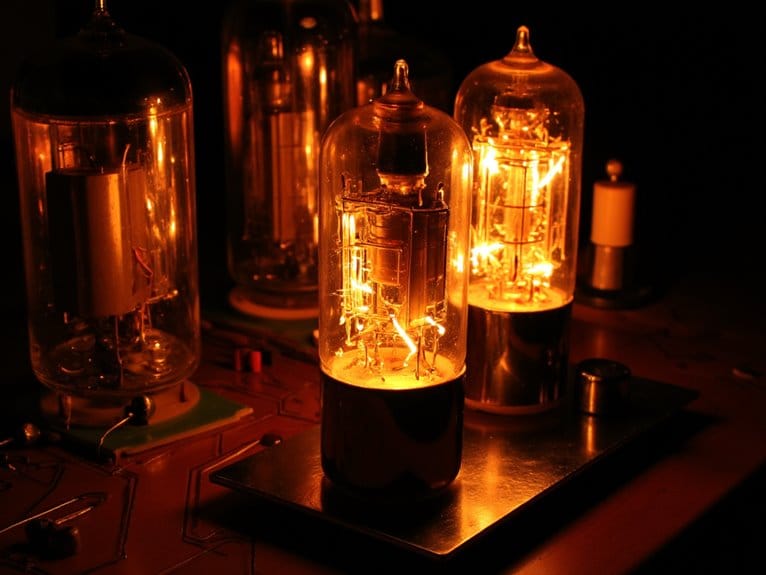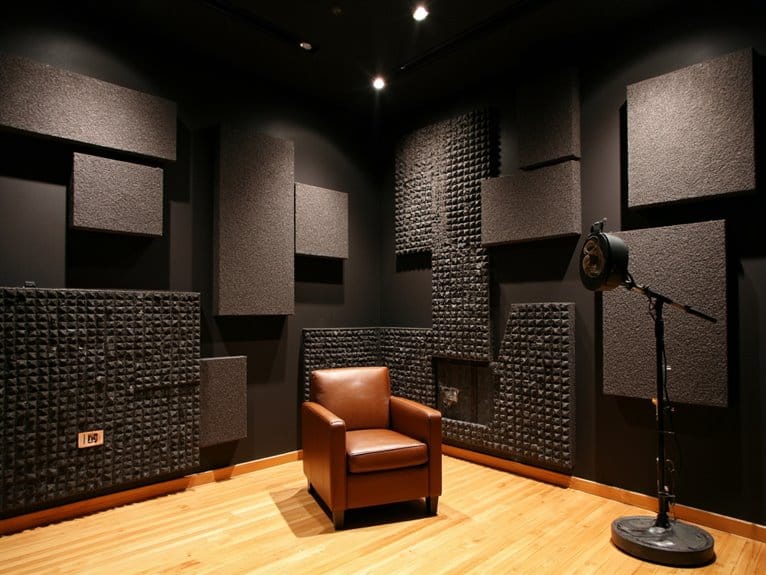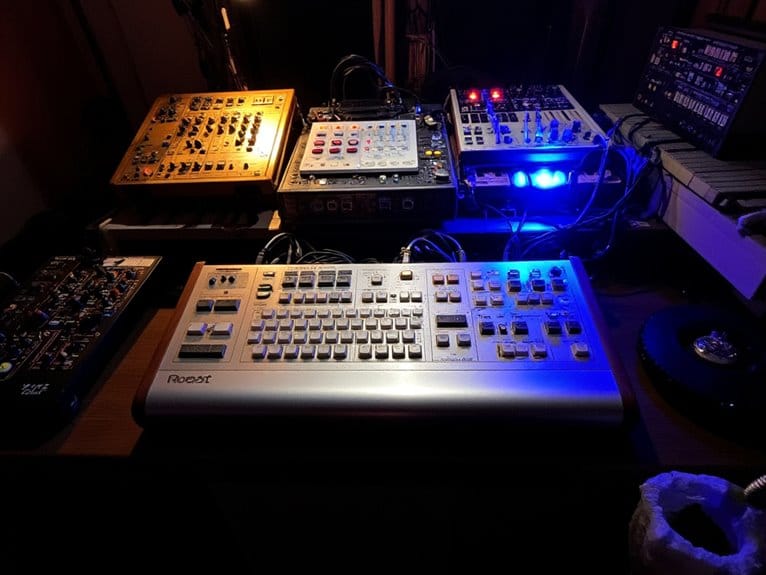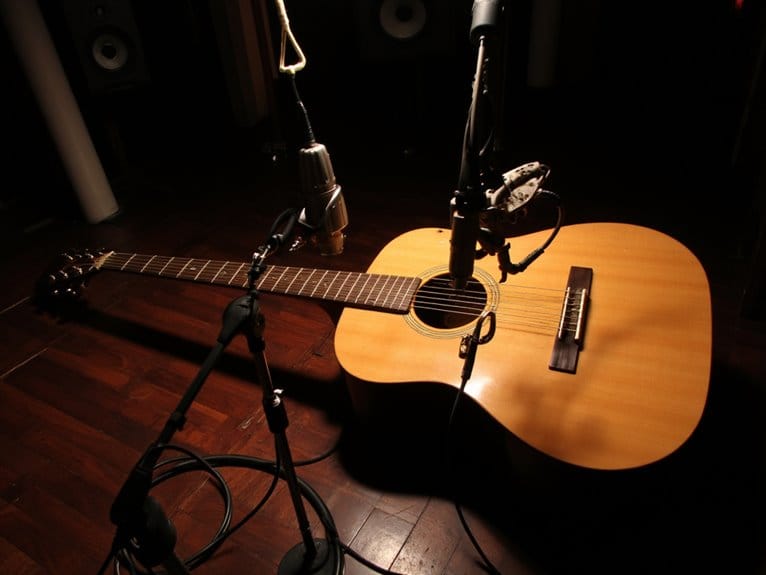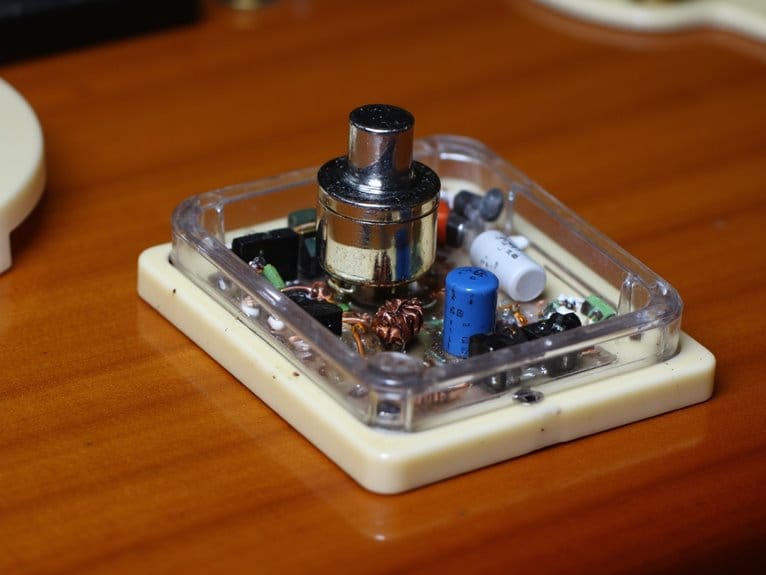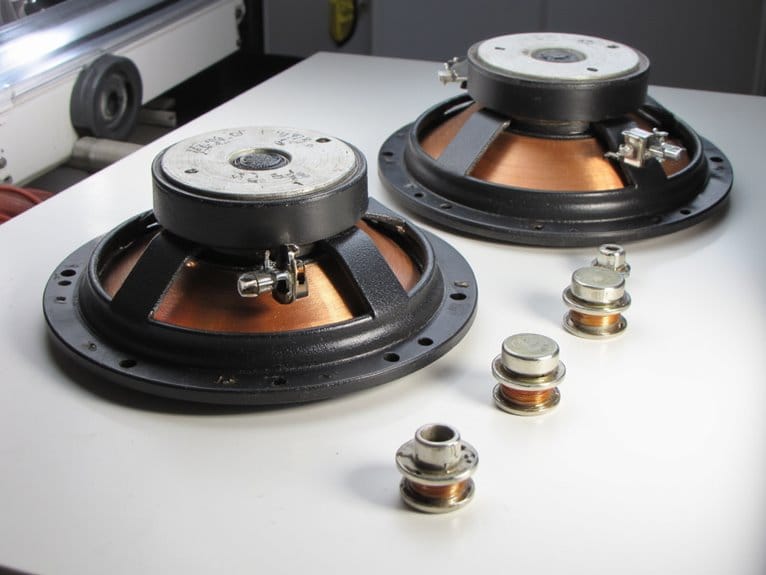Tube Amplification 101: Understanding Valve Technology
Tube amplifiers work by heating cathodes that release electrons into vacuum chambers, where control grids modulate electron flow based on your audio signal before striking anode plates. You’ll find different tube types serving specific functions: preamp tubes like 12AX7 amplify weak signals, power tubes like EL34 drive speakers, and rectifier tubes convert AC to DC power. This process creates the signature warm sound through even-order harmonic distortion and midrange compression that audiophiles cherish, while circuit topology determines whether you’ll experience single-ended Class A richness or push-pull efficiency configurations that further shape your amplifier’s sonic character.
We are supported by our audience. When you purchase through links on our site, we may earn an affiliate commission, at no extra cost for you. Learn more.
Notable Insights
- Vacuum tubes amplify audio signals by controlling electron flow from a heated cathode to an anode through a modulating control grid.
- Preamp tubes like 12AX7 shape tone and boost weak signals, while power tubes like EL34 drive speakers with amplified output.
- Single-ended Class A designs prioritize tonal richness, while push-pull configurations offer improved power efficiency and output.
- Tube amplifiers generate even-order harmonic distortion that creates the characteristic warm, musically pleasing analog sound signature.
- Different tube types and circuit topologies produce distinct sonic personalities, from smooth triode warmth to higher-gain pentode characteristics.
How Vacuum Tubes Generate and Amplify Sound
When I first started exploring tube amplifiers, I’ll admit the whole process seemed like some kind of audio alchemy, but the underlying physics are actually quite straightforward once you break down the basic mechanism.
The magic begins with electron emission, where a heated cathode releases electrons into the vacuum environment of the glass envelope.
These electrons naturally want to travel toward the positively charged anode, but here’s where things get interesting-the control grid sits between them like a traffic controller.
When you apply your audio signal to this grid, it modulates the electron flow, fundamentally turning a weak input signal into a much stronger output that can drive your speakers with that distinctive tube warmth we all chase.
Essential Tube Types and Their Functions in Amplifiers
The foundation of any tube amplifier rests on understanding the distinct roles that different vacuum tubes play within the circuit, and I’ve found that breaking them down by function makes the whole system much clearer than trying to memorize model numbers.
Diode tubes handle rectification, converting AC power to DC without any signal amplification, while preamp tubes like the ubiquitous 12AX7 boost your guitar’s weak signal and shape its initial tone. Power tubes such as EL34s or 6L6s take that amplified signal and drive your speakers with enough force to wake the neighbors. When it comes to achieving the best sound, understanding each component’s role in your setup is crucial. Experimenting with different tube types can dramatically alter your tone, so consider researching guitar amplifier setup tips that suit your playing style. Additionally, proper speaker pairing and EQ adjustments can enhance your overall musical expression, allowing you to find that perfect sound.
Between these stages, phase inverters split signals for push-pull configurations, and driver tubes condition the signal for ideal power tube performance, creating the complete amplification chain. The classification system also includes different operation types like Class A, AB, B, and C, which determine how the tubes are biased and how they handle the signal throughout its cycle.
Circuit Design and Power Output Configurations
Now that you understand how individual tubes function within the amplification chain, the way these components connect and interact determines everything from your amp’s power output to its distinctive sonic character.
I’ve learned that circuit topology choices affect tone just as much as tube selection itself. Single-ended Class A designs offer simplicity and rich harmonics but sacrifice power efficiency, while push-pull configurations boost output and improve circuit stability through balanced operation. Additionally, the interaction between circuit topology and speaker choice can further shape a player’s unique sound profile. For guitarists seeking versatility, exploring the best combo amps for guitar players can reveal setups that blend the advantages of various designs, allowing for a myriad of tonal possibilities. Ultimately, understanding these parameters enables musicians to make informed decisions tailored to their style and preferences.
I’ve found that triode stages deliver smoother distortion characteristics, though pentodes provide higher gain and power output through their complex internal structures. The ultralinear configuration bridges this gap, offering balanced linearity and power.
Your choice between Class A’s continuous conduction and Class AB’s improved efficiency fundamentally shapes your amplifier’s thermal management requirements and overall sonic personality. Different tube types like EL34 or KT88 significantly influence the sonic character of your system, with each offering distinct tonal qualities that define your amplifier’s voice. Tetrodes introduce a screen electrode that enhances control over electron flow, making them valuable for high-gain applications where precise current regulation is essential.
The Distinctive Sonic Character of Valve Amplification
Although specifications and measurements tell part of the story, I’ve discovered that valve amplification’s true magic lies in its distinctive sonic signature, one that’s shaped by the fundamental physics of how electrons flow through vacuum tubes.
You’ll notice tubes generate mainly even-order harmonic distortion, which your ears perceive as musically pleasing and warm, creating that coveted “analog warmth” that solid-state amplifiers struggle to replicate.
This tonal warmth isn’t just marketing hype-it’s rooted in how tubes naturally compress dynamics and add harmonic richness, particularly in midrange frequencies where vocals and instruments live. Unlike solid-state amplifiers that rely on transistors for amplification, tube amps utilize glass vacuum tubes as their core components, which fundamentally shapes their sound character.
Different tube configurations yield distinct sounds, with 12AX7/EL84 combinations delivering brightness, 6V6GT tubes providing warmth, and EL34 tubes offering more aggressive characteristics.
The result is a sound signature that feels more organic and emotionally engaging, with smoother transients and a relaxed presentation that draws you deeper into your music.
On a final note
You’ve now got the foundation to understand why tube amplifiers continue enchanting audiophiles despite solid-state alternatives dominating the market. While I won’t pretend tubes are perfect-they’re finicky, require maintenance, and generate serious heat-their unique harmonic distortion characteristics and dynamic response create that unmistakable warmth you’ll either love or find overrated. Your ears will ultimately decide if valve technology‘s sonic signature justifies the extra complexity and cost.

